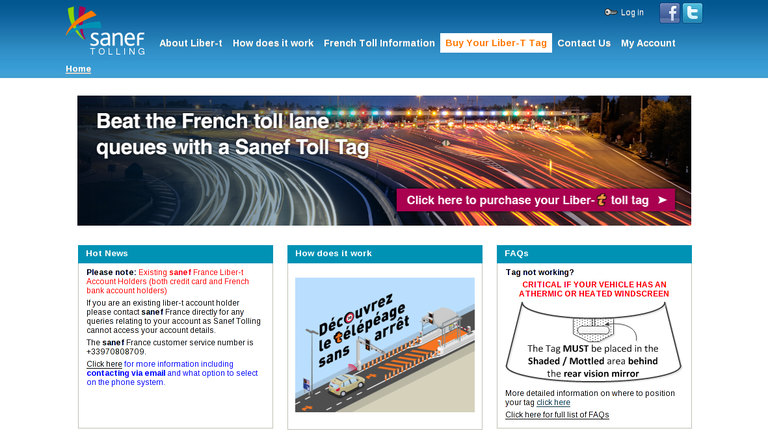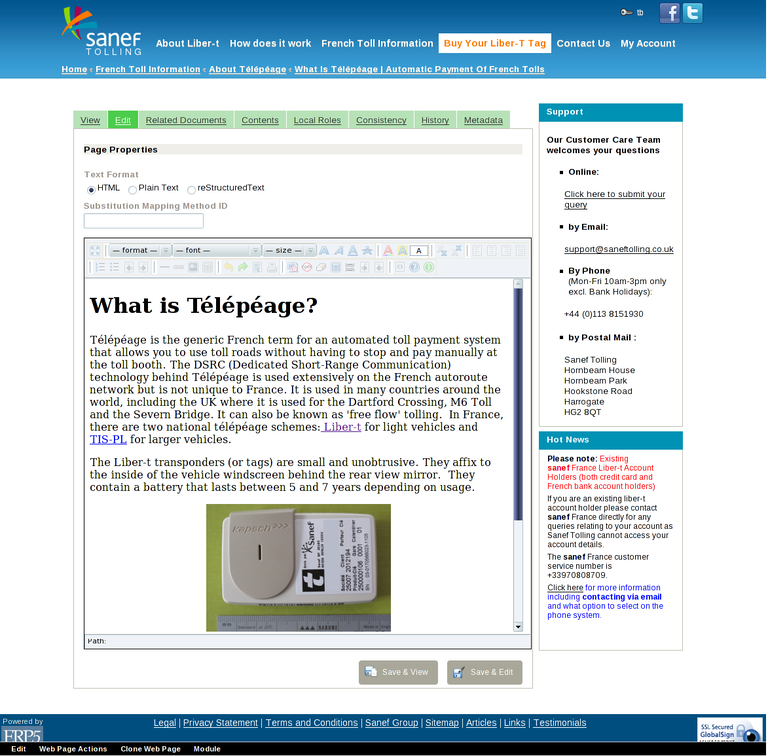Sanef Tolling, a UK based subsidiary
of Sanef, the French motorway operator, has
extended the Liber-t
automated French
tolls payment service to British motorists. All of Sanef Tolling’s IT systems combining frontoffice website and backoffice application are powered by ERP5. Thanks to this complete integration, the eBusiness of Sanef Tolling was able to be launched from scratch in one month and the complete functional scope covered in just three months.
Company Profile
| Name |
Sanef Tolling
|
Staff |
< 10 people
|
| Social form |
Subsidiary of Sanef Group
|
Sites |
1 in UK and 1 in France
|
Business start
|
June 2011
|
Website |
www.saneftolling.co.uk |
Improving the UK motorists experience on French motorways
Driving on French Motorways is often considered by British motorists as a stressful experience : finding the right money when on wrong side of the car is not an easy matter and, when returning home, having to wait in queues at toll plazas can mean possibly missing the ferry. The right solution to this is the French Liber-t telepeage but, until June 2011,
it was difficult for British citizens to subscribe to it because it required to have a French Bank
Account for the Direct Debit payments of the tolls.
Sanef group decided in Spring 2011 to make the life of the millions of UK motorists driving each year in France much easier by extending the Liber-t service to the British Citizens. This was thanks to a new Direct Debit payment option compatible with UK bank accounts. Sanef Tolling, the British subsidiary of Sanef Group is responsible of supporting the English customers in their subscriptions and daily use of the Liber-t service.
To make the operation of the service cost effective, Sanef decided to adopt an eBusiness model for the new English market. Online electronic form submission has become the standard way of subscribing to the service. This benefits from UK Direct Debit standards that allow a paperless setup of Direct Debit Instructions. A selfcare webportal has been chosen as the ideal solution to offer an efficient service around the clock to the customers by making all account management related procedures available online (subscribing, ordering tags, downloading invoices, changing bank details, etc.).
A new IT solution was required to power this innovative Liber-t eBusiness adapted to the English market.
Hurry up, summer time is coming
The annual peak in the number of UK vehicles driving in France can be seen in the summer holiday period, from July to September. That's why Sanef decided to launch the extended liber-T service to British Citizens from the 1st of June 2011, in order to benefit from the large flow of UK motorists coming to France for their holidays.
As the final "go" for the project was agreed at the end of April 2011, there was just one month left to prepare the first version of the Sanef Tolling website and the logistics procedures related to delivery of the tags to the customers before opening the service.
According to Charles Hewson, CEO of Sanef Tolling, "ERP5 was a very good candidate for our project. We knew from other experiences of use of ERP5 inside the Sanef group that the functional scope of the software was large, that it was highly configurable and that it could power websites and provide integration of front and backoffice in a single system".
There were a lot of interfaces with third parties or Sanef group IT Sytems to setup in the project, so the opportunity to avoid the implementation of yet another interface between front and backoffice parts of the IT System was a big advantage, especially as the requirement for value added features proposed to the customers online was high.
ERP5 implementation leitmotiv : "saving time"
Project Key Indicators
| Integrator |
Nexedi |
Time to deliver (open the new service)
|
1 month |
| Modules deployed |
ERP5 Web, CRM, Trade, Accounting, Item
|
Time to cover the complete scope
|
3 months |
| Nb of users |
10 |
Number of interfaces
|
16 |
Focusing on what's essential for the business and meeting the deadlines have been the key drivers in the project implementation. The project has been led by a small team composed of the CEO of Sanef Tolling assisted by a project manager of the company and an experienced Nexedi consultant.
From the early beginning, the critical milestones in the project were agreed:
- M + 1 month : opening of a public website with online subscription of new customers and management of the logistics of tags to be delivered to these customers;
- M + 2 months : complete management of the customer's toll accounts with daily import of the tolls from the Sanef group IT systems and generation of the customer invoices;
- M + 3 months : management of the Direct Debit payment operations.
To reach the first milestone in time, it had been agreed that there would not be any web design phase in the project. As an alternative to a standard web design phase that takes usually more than a month until final approval of the new design, it had been decided to reuse an existing ERP5 website theme and to adapt it in a minimal way in order to comply with Sanef's graphical charter. Thanks to that approach, it has been possible to focus on an essential point related to customers subscription which was compliance with the paperless UK Direct Debit Standards and implementation of third parties webservices to ensure the quality of the data input by the customers (real time UK addresses and bank accounts checks as well as customer's credit worthiness). Time saved here : 1 month.

saneftolling.co.uk website powered by ERP5
The management of the logistics of the tags is another good example of efficient collaboration between Sanef Tolling and Nexedi. Sanef Tolling had a very precise idea about the process to pack and ship the tags to the customers because this had been identified as a critical step in their business from a quality point if view. So, Sanef Tolling project manager developed a web application allowing customer address labels to be printed a tag to be assigned to a customer by simple scanning of the tag barcode and the address label barcode. Nexedi allowed this application to be embedded in ERP5 to simplify its deployment and reuse ERP5 authentication processes. The required webservices were configured in ERP5 in order to interact with the logistics web application. Time saved here : 1 month.
To reach the second milestone in time, it had been agreed to base the ERP5 toll account management on the existing ERP5 banking business template. By considering that the management of a customer toll account in Electronic Toll Collection (ETC) business is quite similar to the management of a customer bank account in the Banking field, it has been possible to reuse the core logic and modules of ERP5 banking and to adapt them to ETC. This approach allowed us to concentrate on the critical interfacing with the Sanef group IT system in order to synchronise the toll transactions between the Sanef Tolling System and the core Sanef group IT. Time saved here by the generic approach considered : 3 months.
Defining roles and Trusting each other in the project team
Considering that Sanef Tolling people knew the tolling business well
and that Nexedi people knew the capabilities ERP5 well, both parties
decided to trust each other :
- Sanef Tolling were in charge of expressing the business needs without trying
to define these directly as system configuration requirements (because they did
not know enough about the ERP5 software);
- Nexedi people were in charge of advising about the preferred ways to
configure ERP5 to meet the business requirements (and not trying to
adapt the business requirements to the software).
Concerning the setup of the website, thanks to ERP5 content management features, it has been possible also to have a strict separation of roles so that :
- Nexedi people could focus on adapting the webdesign to Sanef requirements and implementing the core logic of the selfcare portal;
- Sanef Tolling could define all the contents of the website and collaborate with a Search Engine Optimization expert in order to drive as many visits as possible to the site.

All the web pages defining the contents of the webiste can be edited directly in the context of the website
Traceability of all interfaces
The most difficult part of the project was related to the implementation of all required interfaces between ERP5 and the other systems involved in the tolling eBusiness. As the time to deliver was short, it was required for ERP5 to adapt to the existing interfaces implemented by the third party applications and reuse their existing APIs regardless of the technical protocols.
The ERP5 application is connected with 5 external systems and implements 16 distinct interfaces (data flows) by using 4 different technical protocols : a synchronisation protocol (SyncML) is used to synchronise data related to tags in ERP5 with the core IT system of Sanef Group, REST webservices is actioned to implement the interactive address and bank account data validation methods from the selfcare portal, SFTP exchanges of flat TXT files are used to import the toll transactions and SFTP exchanges of XML files are used to manage Direct Debit operations.
At the ERP5 side, all interfaces have been implemented in a way that guarantees traceability of the data flows : all the files that are transmitted through SFTP between ERP5 and other applications are stored in ERP5 document management system to keep a detailed history of all operations; all results of REST webservices received by ERP5 from external services are stored in the database to be able to explain, at any time, where the data comes from. Combined to native traceability in ERP5 of data modifications done by users, this approach provides a complete audit trail about all the changes to an ERP5 record whether they are related to interfaces or to user input.
Telepeage for all
Within just a few months, Sanef Tolling registered several thousands English customers and could demonstrate that many British citizen were waiting for such a telepeage solution and are happy with the proposed eBusiness and especially the online selfcare portal. The ERP5 tolling solution that has been deployed for Sanef Tolling may now face an important growth of its database especially if it gets extended to new countries in Europe.
Lessons Learnt
|
Integration of front and back office solutions in an eBusiness saves a lot of time and allow to concentrate on what's essential
Building a short project team and defining precisely the roles of each member is the key to reduce project management tasks
|
When the time to deliver is short, you need to have a clear view about the critical chain in the project
The most important around interfaces (whatever protocol is used) is to design them by having in mind that everything can always fail and that traceability is the key
|